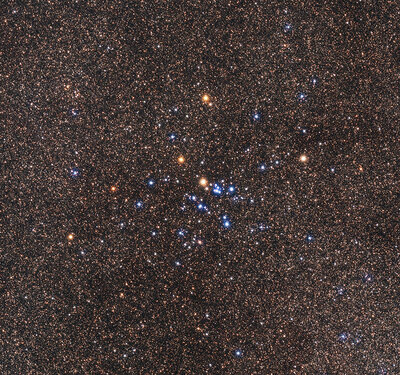by barretosmed » Thu Aug 12, 2021 9:28 pm
MESSIER M25 – OPEN CLUSTER IN THE CONSTELLATION OF SAGITTARIUS
M25, also designated IC4725, was discovered by Philippe Loys de Chéseaux in 1745 and cataloged by Charles Messier in 1764.
It has an apparent magnitude of 4.6, is an object little photographed, being observed with the naked eye, in areas of low light pollution, as a faint diffuse spot in the sky.
Messier 25 does not have an NGC number because, for an unknown reason, John Herschel did not include it in his General Catalog.
Astronomer John Louis Emil Dreyer added M25 to the second Index Catalog in 1908.
Best details (takes a while to open because the image is gigantic):
https://www.astrobin.com/full/4s7zc7/0/
EQUIPMENT:
ZWO ASI 6200MC PRO COLED
Espirit 150mm
83x 100sec
Date: 07/10/2021
Location: Jales-SP-Brazil
Name: Fernando Oliveira de Menezes
E-mail:
Barretosmed@hotmail.com
- Attachments
-

[size=120][b]MESSIER M25 – OPEN CLUSTER IN THE CONSTELLATION OF SAGITTARIUS[/b][/size]
M25, also designated IC4725, was discovered by Philippe Loys de Chéseaux in 1745 and cataloged by Charles Messier in 1764.
It has an apparent magnitude of 4.6, is an object little photographed, being observed with the naked eye, in areas of low light pollution, as a faint diffuse spot in the sky.
Messier 25 does not have an NGC number because, for an unknown reason, John Herschel did not include it in his General Catalog.
Astronomer John Louis Emil Dreyer added M25 to the second Index Catalog in 1908.
[b]Best details (takes a while to open because the image is gigantic):
[/b]https://www.astrobin.com/full/4s7zc7/0/
[b]EQUIPMENT:
[/b]ZWO ASI 6200MC PRO COLED
Espirit 150mm
83x 100sec
[b]Date[/b]: 07/10/2021
[b]Location[/b]: Jales-SP-Brazil
[b]Name[/b]: Fernando Oliveira de Menezes
[b]E-mail[/b]: Barretosmed@hotmail.com
[img2]URL to image file (which must be to the image itself)[/img2]